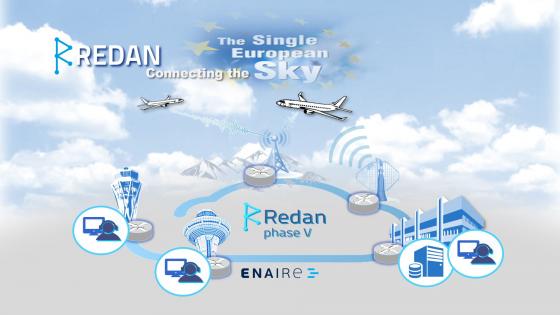
ENAIRE has successfully completed the project that, from 2014 to 2020, saw the deployment and commissioning of the fifth generation of its Air Navigation Data Network (REDAN V).
This network, which includes transport and other value-added elements, integrates voice and data communications for air navigation, providing coverage at every airport, air traffic control centre and, in general, any location that generates or uses aviation information.
As a result, REDAN now allows ENAIRE's communications, navigation, surveillance and air traffic management (CNS/ATM) systems to be interconnected, providing voice and data services with the required service quality in terms of availability, flexibility and security. It also allows connecting these systems with the networks of other air navigation service providers and, in general, with any aeronautical communications network: PanEuropean Network Services (NewPENS), providers of ACARS/ATN (Aircraft Communications, Addressing and Reporting System and Aeronautical Telecommunications Network) services, Spain's National Meteorological Agency, Ministry of Defence, etc.
REDAN V allows transmitting much more information at a lower cost
The deployment of REDAN V involves more than one hundred different stations, basically including all airports and military bases, air traffic control centres (route and approach), radar stations and ground/air communications centres. Its concept and design stem from ENAIRE's extensive experience in aviation communication networks and from a permanent innovation strategy, as well as from the know-how and experience gained over many years of working in international environments and projects, all of which have made ENAIRE a pioneer service provider in this field.
More efficient communications
This project, which came about to address both technological issues (obsolescence and the need to satisfy new user needs) and financial concerns, uses technologies that allow broadcasting much more information at a lower cost.
The most significant technologies from the user's point of view are those derived from the SWIM (System Wide Information Management) concept, which will help improve aviation safety and lead to the more efficient use of airspace and those applications that are required to implement the PCP (Pilot Common Project) EU law.
At the start of the project, it was estimated that it would save almost three million euros annually in terms of procuring communications services, but the capacity it currently offers makes these savings even greater. The project also yields indirect economic benefits by allowing ENAIRE to implement new air navigation applications that increase operational efficiency and streamline system maintenance.
The approximate cost of this project was 47 million euros, which includes a grant of 20.4 million euros from the CEF (Connecting Europe Facility) programme that INEA (Innovation and Networks Executive Agency) manages for the European Commission. This project is fully consistent with the goals of the Single European Sky and was included as part of the SESAR (Single European Sky ATM Research) deployment programmes.
Relevant features
The new network's most relevant technical features include the power and flexibility of the MPLS (MultiProtocol Label Switching) protocol, the dual operator infrastructure as a physical link between the different network sites, and the integration of ATC voice communications using VoIP (voice over IP) technology.
The dual operator infrastructure, another first in these environments, provides for a 99.999% availability of the link infrastructure, a figure that guarantees compliance with the most demanding operational safety requirements.
The integration of ATC voice communications via VoIP offers considerable advantages, such as a significant improvement in voice quality, a high degree of scalability and flexibility and lower operating costs. Its scalability and flexibility provide a quick and easy response to the increased demand for capacity, as well as to any reconfigurations that may be needed in the event of a catastrophic failure. This feature has allowed ENAIRE to implement an ambitious ATC contingency strategy.
The project also includes rigorous operational safety studies, which were validated by the National Aviation Safety Agency (AESA) in strict compliance with the applicable procedures of the European Single Sky regulatory framework.
